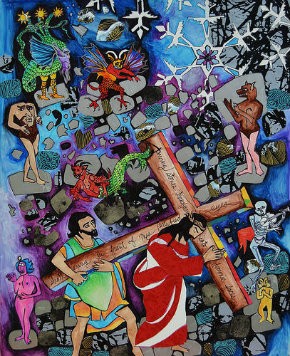The Passion and mental illness

The Passion is a tremendous drama. It is the story of the violent execution of a political dissident by an empire that routinely ignored the margins of society. Today, the symbols and patterns of the Passion story—the cross, the cloth used to wipe Jesus’s bloodied face, the garments stripped from his body, the nails hammered into his sides—are incorporated into a story we take on as our own.
For five years, I’ve been making art about the last day of Jesus’s life. Each of these Stations of the Cross projects has taken on a different social justice and advocacy issue. The first, in 2010, was created in the wake of the Haitian earthquake. Its 14 stations take Haitian artists’ images of Eden and incorporate them into paintings of Passion. My second Stations series explores the uprising in Syria. It follows the cataclysmic horror of the events as they unfolded, incorporating illustrations of the uprising with Jesus and the cross at the center of each.
In the 2013 Stations of the Cross: The Struggle for LGBT Equality, I examine queer history through the lens of Martin Luther King Jr.’s observation that “the arc of the moral universe is long, but it bends toward justice.” The following summer I began teaching art at the Shelby County Jail in Memphis. This led to Stations of the Cross: Mass Incarceration, which crafts a narrative about the legal, historical, and cultural structures that have made it possible for the United States to incarcerate 2.5 million people.





